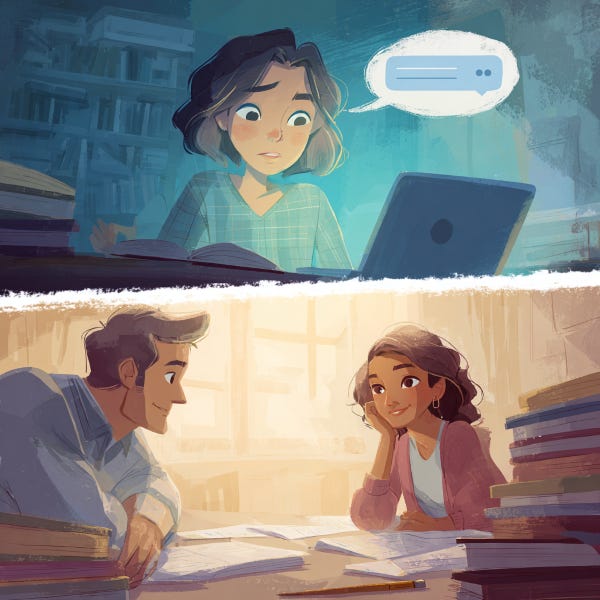Every AI Tool Teaches. The Question Is: What?
What every AI education tool teaches students—whether we intend it to or not
Picture this. A student asks an AI tutor for help and gets an instant answer. It feels efficient. Maybe even empowering—for a moment. But now picture that same student working through a problem with a teacher who pauses and asks, “What do you think?” That moment feels different. Slower. Messier. And it teaches something different—not just about the subject at hand, but about what learning itself is supposed to feel like.
That’s the hidden curriculum.
It’s not the official lesson plan or rubric. It’s what students come to believe about learning from the way systems actually work. And AI tools, whether we realize it or not, are now part of that system. They don’t just deliver content. They shape students’ beliefs about:
What knowledge is
How learning works
Who they are in relation to the systems around them
Unless we’re intentional, those lessons may not be the ones we want students to carry.
The Unseen Lessons of AI
AI tools weren’t built to be teachers—but the moment we use them, they start teaching.
AI tutors often suggest that learning is about answers, not inquiry. That speed matters more than depth. That confusion is a flaw to be avoided—not part of the process to be embraced.
Behavior prediction tools send a different message. Imagine a student who’s having a rough morning—maybe they didn’t sleep well, or there’s stress at home. A teacher might notice and ask, “How are you doing today?” But an algorithm, seeing only patterns in data, flags them as “high risk for disruption” before they even speak. One interaction says, “I see you as a whole person.” The other says, “I see you as a pattern to predict.”
And automated assessment platforms? They signal that what counts is what can be standardized, measured, and scored. That creativity and critical thinking are optional extras—not essentials. That worth is what fits into neat data boxes.
None of this happens because educators want it to. It happens because tools without intentional design default to the values of their creators—or the systems that adopt them.
What We Actually Want Our Tools to Teach
Ask any educator what we hope students learn about learning, and it sounds very different. We want students to believe that:
Learning is curiosity, struggle, and discovery—not just speed and answers.
Agency matters—they are thinkers, not patterns.
Knowledge is human, complex, and worth wrestling with—not just what’s easy to score.
The gap between these values and what many AI tools teach? The good news is: this isn’t inevitable. We can choose differently.
A Reality Check
Of course, many educators reading this are thinking: “I didn’t choose these tools—they were chosen for me.” That’s the reality in many districts. But even when we can’t control which tools we use, we can control how we use them. We can name their limits. We can pair algorithmic “personalization” with real relationships. We can help students think critically about the feedback they get from AI. Our agency might feel limited—but it’s not gone.
This Is Where CRAFT Can Help
This is where intentional frameworks become essential.
CRAFT is a human-centered design framework I developed through school leadership experience to help educators make equity-centered choices without burning out. The name reflects five design pillars:
C – Context Representation: Does this tool reflect the complexity of who our students are?
R – Reciprocity & Co-Design: Were students, families, or educators part of shaping how this tool works?
A – Accessibility of Language: Does the tool communicate in ways that feel human and clear?
F – Flexibility Without Burden: Does it create choices that empower rather than overwhelm?
T – Time & Capacity Respect: Does it help us focus on what matters, or just add more to manage?
CRAFT isn’t anti-technology. It’s pro-intention. It helps us slow down and ask better questions before we adopt or rely on AI.
What Good Looks Like
So what does intentional AI integration look like? It might be an AI writing tool that helps students brainstorm ideas while still requiring them to decide on structure and voice—a great example of pairing Flexibility Without Burden with Agency. An AI tutor that offers follow-up questions rather than just answers—reflecting Accessibility of Language and Context Representation. An assessment platform that helps teachers spot learning patterns while preserving space for teacher judgment about what those patterns mean—showing Time & Capacity Respect in action.
These tools don’t replace human connection—they amplify it.
What Students Notice
Because students notice.
They notice when the chatbot hands them the answer without helping them understand it. They notice when an algorithm predicts they’ll act out before they’ve even entered the room. They notice when the system labels them as behind—while the teacher in front of them sees their growth.
You can almost hear it:
“I used to ask my teacher when I got stuck, but now I just ask the chatbot because it’s faster.”
That shift isn’t small. It’s one of the hidden lessons of AI. And it sticks.
The Real Question
Every tool teaches.
AI will shape student beliefs—whether we guide that process or not.
So the real question is: What do we want AI to teach?
And are we choosing tools—or using tools—in ways that match that vision?
Next time you encounter an AI tool in your school, pause and ask: What hidden lesson does this teach? Is that the lesson we want students to learn?
P.S. If this resonated, you might explore these next:
What is CRAFT — a deeper look at the framework behind these questions, and how it helps make equity a daily design practice
We’re Teaching AI to Think Like Our Worst Systems — how CRAFT can guide AI to reflect care and equity rather than amplifying harmful patterns
The Shortcut Rebellion — why student AI use is feedback on system design, not just a cheating crisis



